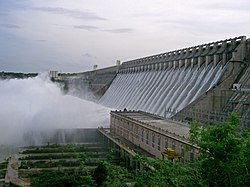Nalgonda District is a district in Andhra Pradesh.
Its name is derived from two Telugu words Nalla (Black) & Konda (Hills) i.e. Black Hills.
Nalgonda was earlier referred to as Neelagiri, the name given by some Rajput rulers and the name was changed to Nallagonda only after its conquest by Allauddin Bahaman Shah, aBahamani king.
Goddess Diety relief near Nagarjunakonda
Lateef Saheb Darga at Nalgonda
Nalgonda District's place in Telangana Rebellion history
Main article: Telangana Rebellion
It has a major role in the Telangana Rebellion. Much of the struggle revolves round Nallagonda and Warangal districts alone and later spread to other regions as well. Almost all the villages in the district were involved in this. the movement was led by Andhra Maha Sabha and Communists. Marshall Law was imposed in the Dist. in 1946. Many people were killed by Razakars or by feudal lords goons and Nizam's armies. Some 3000–5000 villages were liberated and self-governing bodies were formed. Lands were distributed among the poor. Many feudal landlords " Jagirdaars " were killed or ripped of their properties. Battles raged between Communists and Razakars (and Nizam's armies ). Finally this ended with Indian Forces "Police Action" and Telangana along with Hyderabad state is merged into Indian Union.
Many leaders like Bheemireddy Narasimha Reddy, Raavi Narayana Reddy, Mallu Swarajyam (woman revolutionary) and her husband, Arutla Ramachandra Reddy and his wife, poets likeBandi Yadagiri, Suddala Hanumanthu, etc. played an important role in the movement.
The district's (peoples) part in the rebellion is even immortalized in the poetry of the Movement which were popular then. These were used as a means to enlighten the common people about the revolt and its leaders. one such poem by Bandi Yadagiri (Venkepally Village Nuthankal Mandal), who penned the famous song "
Nalgonda district occupies an area of approximately 14,200 square kilometres (5,500 sq mi),comparatively equivalent to Indonesia's
Towns in the district include: Nalgonda, Suryapet, Miryalaguda, Bhongir, Kodada, Nakrekal, Choutuppal, Chityal, Ramannapeta, Kattangur, Bhoodhan Pochampally, Aleru, Narkatpalli,Huzurnagar, Devarakonda, Yadagirigutta, Rajapet, Mothkur, and Kanegal.
The rivers Krishna, Musi River, Aleru, Peddavagu, Dindi and Paleru flow through the Nalgonda district.
Clean drinking water, water supply for irrigation and educational facilities for all are perhaps the most important problems Nalgonda faces right now.
Nearly 500 villages in Nalgonda district are affected by the high fluorine content in water. It is estimated that nearly 1 million people are affected by Fluorosis in Nalgonda district.
Parada village under Kattangur Mandal was suffering due to drinking water; almost all the villages were supplied with water from Krishna except this village.
Divisions
1.Nalgonda
2.Suryapet
3.Miryalaguda
4.Bhongir
5.Devarakonda(Sub Division)
Mandals:
1 Bommala Ramaram 2 Turkapally 3 Rajapeta
4 Yadagirigutta 5 Alair 6 Gundala
7 Tirumalagiri 8 Thungathurthy 9 Noothankal
10 Atmakur (S) 11 Jajireddigudem 12 Saligowraram
13 Mothkur 14 Atmakur (M) 15 Valigonda
16 Bhongir 17 Bibinagar 18 Pochampally
19 Choutuppal 20 Ramannapeta 21 Chityal
22 Narketpally 23 Kattangur 24 Nakrekal
25 Kethepally 26 Suryapet 27 Chivemla
28 Mothey 29 Nadigudem 30 Munagala
31 Penpahad 32 Vemulapally 33 Thipparthy
34 Nalgonda 35 Munugode 36 Narayanapur
37 Marriguda 38 Chandur 39 Kanagal
40 Nidamanoor 41 Tripuraram 42 Miryalaguda
43 Garidepally 44 Chilkur 45 Kodad
46 Mellachervu 47 Huzurnagar 48 Mattampally
49 Neredcherla 50 Damercherla 51 Anumula
52 Peddavoora 53 P.A.Pally 54 Gurrampode
55 Nampally 56 Chintapally 57 Devarakonda
58 Gundlapay 59 Chandampet |
Yadagiri Gutta, which is the most devotional place in Nalgonda is located near Bhuvanagiri Town. It is close to Hyderabad, the capital city and the APSRTC runs many buses to the temple town from Mahatma Gandhi Bus Station. The temple draws huge crowds, especially during vacations and on weekends. This is the Place of worship of Lord Laxmi Narasimha Swami.
Nagarjuna Sagar World's largest masonry dam This is famous Dam in south India with 26 gates and a Hydroelectric plant. The place also hosts waterfalls called 'Ethipothala' and Gowthama Buddha Museum.
Bhuvanangiri Fort was built by Tribhuvanamalla Vikramaditya VI on an isolated rock. The Bala Hisar or citadel on the top of the hill gives a bird's eye view of the neighbouring area. The fort is associated with the herioc queen Rudramadevi and her grandson Prataparudra's rule.
PillalaMarri is one of the oldest Lord Shiva temples which is considered to be 1000 years old. Pillalamarri, being the birthplace of the famous Telugu poet Pillamarri Pina Virabhadrudu, is not only historically but also culturally and religiously significant.










0 comments:
Post a Comment